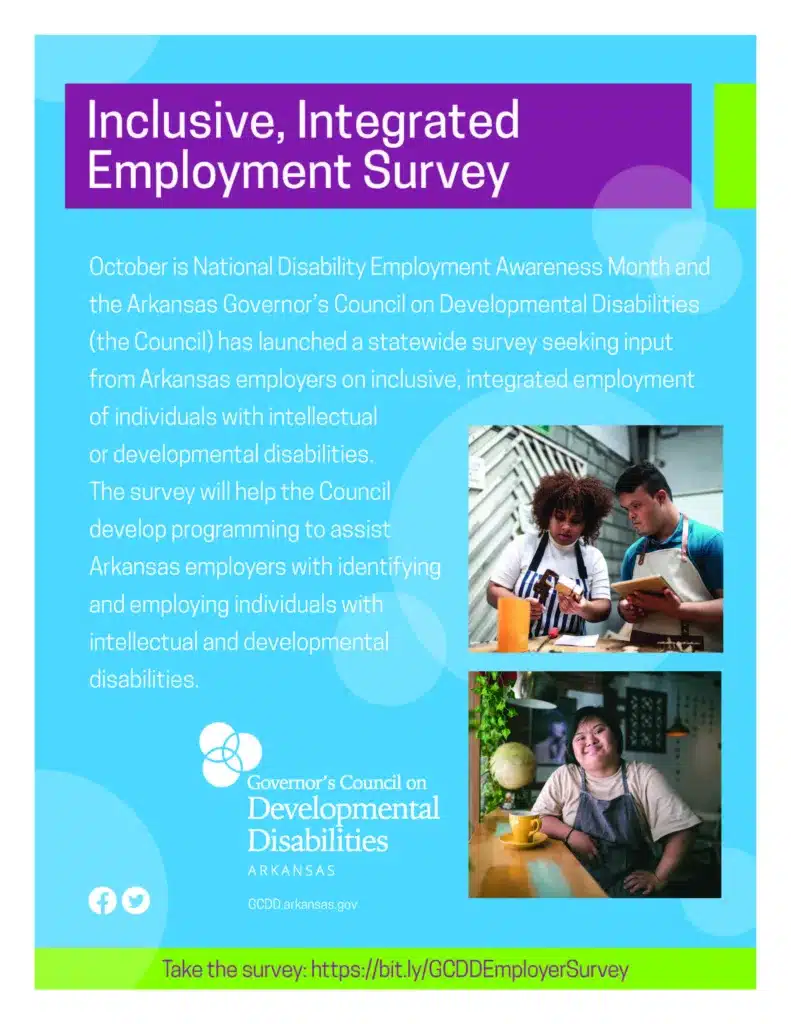Pam
By Jon Taylor
Two weeks ago I wrote about two summers with Ahmad and Alik. They came to me through a program sponsored by Arkansas Workforce Services (AWS). During that time, I was building a partnership with another state agency that also focused on Disability and Inclusion: Arkansas Rehabilitation Services. ARS’ mission is to prepare Arkansans with disabilities to work and lead productive and independent lives. To achieve that mission, ARS provides training and career preparation programs to its clients. Once that training is complete ARS case managers work with businesses to place their clients in permanent competitive, integrated employment.
For clarity, competitive, integrated employment means:
- Competitive. Refers to wages that are at least minimum and ideally prevailing wages (not how person got the job). As of October 2021, minimum wage in Arkansas is $11 an hour, and will be $12 an hour by 2023.
- Integrated. Refers to work occurring in a typical work setting where the employee with a disability interacts (or has the opportunity to interact) continuously with co-workers without disabilities. The employee with a disability is part the team and is held to the same standards and work rules as everyone else. Work in small groups or enclaves does not meet the CIE definition, even if pay is competitive and setting is integrated.
- Employment. Must be an individual employment situation where the employee is paid directly by their employer. The employee is not part of an outside training program that covers just their payroll.
Before ARS refers a client, the managers in the prospective employer go through a formal Disability Etiquette training. That training covers the major “Do’s” and “Don’ts” around employing someone with a disability (the training is also great for teaching companies how to interact with customers with disabilities too). No program covers all possible situations, but between my team’s own experience with the AWS summer sessions and the new training, we all felt confident in our ability to create and manage a truly inclusive workplace. So, ARS referred their first client: Pam.
An ARS referral didn’t mean their client would be automatically hired. At the beginning of my relationship with ARS it meant I would review the application of their client and conduct a first interview. The disability of the client was never disclosed. If the client wanted to discuss it, they could, but if they didn’t want that was fine too.
Pam’s interview was one of the most memorable I’ve ever had. She was funny, articulate, and very high energy – almost too high energy. As extroverted as she was, I asked her how I should manage her. She told me all I had to do was tell her to turn the energy down a bit, and she would. So, in 2016 I hired Pam.
At the beginning Pam was everything I hoped she would be – a fast learning, hardworking, team playing employee. We gave her as many hours as she could handle, and we were glad to have her. Then one day, Jim, my Store Operations Manager called me to the front of the store. He was kneeling by Pam, who was sitting in the middle of the floor in a cold sweat. The high energy was gone. She was tired, struggling for breath, and couldn’t even stand up. Jim and I were about to call 911 when Pam said, “I’ll be fine. I had a change to my meds. I’ll be fine in a few days”.
And in a few days, she was back to “normal” – sort of. Pam worked mostly as a cashier. As outgoing as she was, she was ideally suited for customer facing roles. But now Pam was struggling to maintain the high energy to be her usual bubbly self. So, Jim cross-trained her to do other things in the store: receiving, stocking, markdowns. If Pam was able to work directly with customers, she was a cashier. If not, she would be in the backroom or be part of an early morning stocking team. Her work ethic never wavered. Pam was productive wherever she was assigned. Over time she became indispensable when it came to markdowns and inventory. And by indispensable, I mean I picked her up at 4 AM in a snowstorm to help do our annual inventory. It would not have gone right without her.
During this time Pam was still a client of ARS, and we reported her progress back to her client manager on a regular basis. ARS was pleased with how we worked with Pam, and felt we were a good model of an inclusive workplace. ARS, along with an organization I was not yet familiar with asked Pam and I to share our story in a short video about inclusive hiring (the link to our video is at the end of this post). That other organization was the Governor’s Council on Developmental Disabilities. That was spring 2018.
Looking back Pam taught all of us a great deal about what it means to truly practice inclusive hiring. Specifically, we learned four principles:
1. Can the person do the job? Focus on what someone can do and don’t assume you know based on an initial impression. During an interview, review the job description, and ask the applicant if they can fulfill the role. If they can’t it’s okay to say “no”. If they say they can, proceed with the interview.
2. Common Sense Reasonable Accommodations. For example, are strength-based job requirements truly necessary for every employee, or only for certain departments? Flexible scheduling is also an accommodation. Pam road the bus to work, so we moved her start time up to compensate for occasional delay. Plus, the bus had a different schedule on weekends and holidays. Most job requirements are not written in stone. We learned to focus primarily on the core duties of any given job.
3. Will the person fit into our culture? Every organization is different. Every team is unique. During the interview process, we asked ourselves: “Will their personality be a good fit for our team?”. With or without a disability, if someone doesn’t mesh with your team, they will never fully integrate.
At the end of any interview if an applicant could do the job and fit in with the team, I made an offer. It became that simple. After practicing those three principles for a few months we learned the fourth one:
4. All hires are a risk. The risk is the same for every job offer, regardless of whether the applicant has a disability or not. Every experienced hiring manager has at least one horror story where they hired someone who they were sure would be the perfect employee: a flawless cover letter, an amazing resume, impeccable references, and an interview that you never wanted to end. Then an entirely different person shows up for the first day of work.
Hiring a person with a disability is the same risk we take every time we make a job offer. So, take the chance. Your Pam is out there somewhere.
Some final notes about this blog: Pam and I talked about this in advance and she read it before I posted it. She had full veto power over anything I wrote, and she made sure my recollections were accurate.
The link to our video is: https://www.youtube.com/watch?v=sKHgbScnyyQ
In a few months Pam will be moving from Arkansas to Texas. She will be sorely missed by her co-workers in North Little Rock. And I’ll miss her too. We are already Facebook friends, but that’s not quite the same.
So, Pam, if you ever need a ride at 4 AM in a snowstorm, it may take me a bit to get to Texas. But if you call, I’ll be there.
NDEAM SURVEY
The Arkansas Council is seeking input from employers on why they do, or don’t, actively practice inclusive and equitable employment of those with developmental disabilities. During NDEAM, GCDD launched a statewide survey for employers of all company sizes.
The feedback we receive will help us to craft resources to support employers and begin bridging the disability employment gap in Arkansas.
Today, we issue a challenge:
- for Employers, to complete the survey.
- for Partners, to share the survey & our message. Get the Employer Survey Toolkit here.





